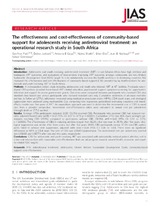| dc.contributor.author | Fatti, Geoffrey | |
| dc.contributor.author | Jackson, Debra | |
| dc.contributor.author | Goga, Ameena | |
| dc.contributor.author | Shaikh, Najma | |
| dc.contributor.author | Eley, Brian | |
| dc.contributor.author | Nachega, Jean B. | |
| dc.contributor.author | Grimwood, Ashraf | |
| dc.date.accessioned | 2018-03-08T12:54:24Z | |
| dc.date.available | 2018-03-08T12:54:24Z | |
| dc.date.issued | 2018 | |
| dc.identifier.citation | Fatti, G. et al. (2018). The effectiveness and cost-effectiveness of community-based support for adolescents receiving antiretroviral treatment: an operational research study in South Africa. Journal of the International AIDS Society, 21(S1): e25041 | en_US |
| dc.identifier.issn | 1758-2652 | |
| dc.identifier.uri | http://dx.doi.org/10.1002/jia2.25041 | |
| dc.identifier.uri | http://hdl.handle.net/10566/3573 | |
| dc.description.abstract | INTRODUCTION: Adolescents and youth receiving antiretroviral treatment (ART) in sub-Saharan Africa have high attrition and
inadequate ART outcomes, and evaluations of interventions improving ART outcomes amongst adolescents are very limited.
Sustainable Development Goal (SDG) target 3c is to substantially increase the health workforce in developing countries. We
measured the effectiveness and cost-effectiveness of community-based support (CBS) provided by lay health workers for adolescents
and youth receiving ART in South Africa.
METHODS: A retrospective cohort study including adolescents and youth who initiated ART at 47 facilities. Previously unemployed
CBS-workers provided home-based ART-related education, psychosocial support, symptom screening for opportunistic
infections and support to access government grants. Outcomes were compared between participants who received CBS plus
standard clinic-based care versus participants who received standard care only. Cumulative incidences of all-cause mortality
and loss to follow-up (LTFU), adherence measured using medication possession ratios (MPRs), CD4 count slope, and virological
suppression were analysed using multivariable Cox, competing-risks regression, generalized estimating equations and mixedeffects
models over five years of ART. An expenditure approach was used to determine the incremental cost of CBS to usual
care from a provider perspective. Incremental cost-effectiveness ratios were calculated as annual cost per patient-loss
(through death or LTFU) averted.
RESULTS: Amongst 6706 participants included, 2100 (31.3%) received CBS. Participants who received CBS had reduced mortality,
adjusted hazard ratio (aHR) = 0.52 (95% CI: 0.37 to 0.73; p < 0.0001). Cumulative LTFU was 40% lower amongst participants
receiving CBS (29.9%) compared to participants without CBS (38.9%), aHR = 0.60 (95% CI: 0.51 to 0.71);
p < 0.0001). The effectiveness of CBS in reducing attrition ranged from 42.2% after one year to 35.9% after five years. Virological
suppression was similar after three years, but after five years 18.8% CBS participants versus 37.2% non-CBS participants
failed to achieve viral suppression, adjusted odds ratio = 0.24 (95% CI: 0.06 to 1.03). There were no significant
differences in MPR or CD4 slope. The cost of CBS was US$49.5/patient/year. The incremental cost per patient-loss averted
was US$600 and US$776 after one and two years, respectively.
CONCLUSIONS: CBS for adolescents and youth receiving ART was associated with substantially reduced patient attrition, and is
a low-cost intervention with reasonable cost-effectiveness that can aid progress towards several health, economic and equality-
related SDG targets. | en_US |
| dc.language.iso | en | en_US |
| dc.publisher | Wiley Open Access | en_US |
| dc.rights | © 2018 The Authors. Journal of the International AIDS Society published by John Wiley & sons Ltd on behalf of the International AIDS Society. This is an
open access article under the terms of the Creative Commons Attribution License, which permits use, distribution and reproduction in any medium, provided the
original work is properly cited. | |
| dc.subject | HIV | en_US |
| dc.subject | Antiretroviral treatment | en_US |
| dc.subject | Adolescents | en_US |
| dc.subject | United Nations Sustainable Development Goals | en_US |
| dc.subject | Community-based support | en_US |
| dc.subject | Cost-effectiveness | en_US |
| dc.title | The effectiveness and cost-effectiveness of community-based support for adolescents receiving antiretroviral treatment: an operational research study in South Africa | en_US |
| dc.type | Article | en_US |
| dc.privacy.showsubmitter | FALSE | |
| dc.status.ispeerreviewed | TRUE | |

